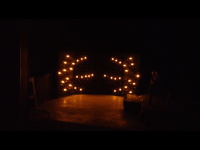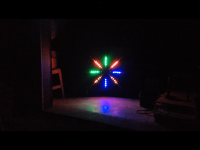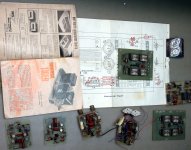They are not “weird” numbers - just RCA house numbers like Motorola’s MJ. 40xxx was metal can, and we’re generally available to any OEM (not protected by NDA to a single customer). The diff pair was the 40406. This was back when Mouser and Digikey didn’t carry **** anyway, and you needed at tax ID to order from the big boys. Experimenter still had a hard time getting their hands on them new, but scavengers get pulls could because the circuit was common as dirt.
If we could still get the 40409 and 40410 we’d still be using them. And no, I won’t buy ECG 128/9.
If we could still get the 40409 and 40410 we’d still be using them. And no, I won’t buy ECG 128/9.
We went further than that - we were on the cheap. Back in the day our little band of bandits built disco light systems by using literally hundreds of C9 Christmas lights. All manner of digital logic hooked to a bank of triacs, with the audio coupled in by transformer. Here is a pair of the survivors, with the LED retrofit bulbs. The videos didn’t work here, but you can get the idea.Good topic as well.
Sound and light work together well.
Very early on that was my electrical endeavors.
Since rather easy and " lamps" are accepted easy with no transformer.
So many coffee cans and lamps in the trash.
Become rather elaborate lighting systems.
Really blossomed in high school when I got almost endless colors from
school theatre gels. And actually made gel frames over coffee cans.
Very intense pinks and purples , colors people didnt see often.
I remember the genesis of the whole thing too. We were sitting around watching Grease for the 200th time, and it was the scene at the end where Sandy and Danny were dancing in the “Shake Shack”. And thought “you know we could build something like that”.
Attachments
40409 was used with 2n3055 in braun CSV500 . I replaced many 40409 :-(Sometime in the late 60's RCA brought out a line of transistors with weird numbers based on the 2N3055. There were a pair of complementary TO-5 drivers that came welded to square heat sinks, the 40409 and 40410, and the "mega3055" called the 40411. I believe that there was a predriver transistor often used in the diff pair front end, 40408 maybe. They published a "50 watt" quasi complementary amp circuit in the RCA Transistor Thyristor & Diode manual, SC-14 maybe. Instantly that circuit became the "standard design" for many HiFi and guitar amps.
All the Kustoms, some of the Acoustics, that horrible Fender PA amp that had no airflow and therefore blew up a lot, and even the big Heathkit guitar amp used exactly the same circuit. The Kustom K200 series (100 real watts) used two of the same circuits in parallel. Most were quite reliable.
I believe that the SWTPC Universal Tiger used a similar circuit, maybe it was full Complementary Symmetry, don't remember for sure.They are not “weird” numbers - just RCA house numbers like Motorola’s MJ. 40xxx was metal can, and we’re generally available to any OEM (not protected by NDA to a single customer). The diff pair was the 40406. This was back when Mouser and Digikey didn’t carry **** anyway, and you needed at tax ID to order from the big boys. Experimenter still had a hard time getting their hands on them new, but scavengers get pulls could because the circuit was common as dirt.
If we could still get the 40409 and 40410 we’d still be using them. And no, I won’t buy ECG 128/9.
I got those funky RCA transistors at the local Heathkit store.
Attachments
Universal Tiger Got a rugged cool look to it.
almost like a tube amplifier block.
Seems Similar construction people were familiar with
in early transition to solid state.
Ready to go in a huge console or something
when speakers looked like furniture.
What magazine is that? Be a great read. Might be able to find a digital copy at least
,,,edit,,, well that was easy, came up pretty quick Popular Electronics Oct 1970
almost like a tube amplifier block.
Seems Similar construction people were familiar with
in early transition to solid state.
Ready to go in a huge console or something
when speakers looked like furniture.
What magazine is that? Be a great read. Might be able to find a digital copy at least
,,,edit,,, well that was easy, came up pretty quick Popular Electronics Oct 1970
Last edited:
The Tigers were altogether different animals, operating the output stages with gain. To make them safe under hard use, they desperately needed Baker clamps. And prone to construction- related instabilities. One could make them work if they knew what they were doing, but don’t drive a stock one 10 dB into clip.
Tigersauras was a stupid idea. You don’t do that voltage-splitting thing on an output stage with gain. That’s just asking for trouble. With followers you had a chance - and then the only one to get that right was Leach with the double barreled amp. You needed a triple there, to keep the voltage division under dynamic conditions where driver base currents are substantial.
If you built one today - stacked or otherwise - using MJ15003/4 you’d also save yourself a lot of grief. MJ802 is NOT up to the task. It sure looks pretty on paper until you see that abysmal SOA graph. It’s real, BTW. Everybody else who made stacked output stages at least used 2N5630’s - which we’re up to the task. MJ802 were time bombs running off regular +/45V rails in a classic circuit. Replaced way too many of them back in the day. With D424/B554 and never looked back.
Tigersauras was a stupid idea. You don’t do that voltage-splitting thing on an output stage with gain. That’s just asking for trouble. With followers you had a chance - and then the only one to get that right was Leach with the double barreled amp. You needed a triple there, to keep the voltage division under dynamic conditions where driver base currents are substantial.
If you built one today - stacked or otherwise - using MJ15003/4 you’d also save yourself a lot of grief. MJ802 is NOT up to the task. It sure looks pretty on paper until you see that abysmal SOA graph. It’s real, BTW. Everybody else who made stacked output stages at least used 2N5630’s - which we’re up to the task. MJ802 were time bombs running off regular +/45V rails in a classic circuit. Replaced way too many of them back in the day. With D424/B554 and never looked back.
That particular magazine was the Electronic Experimenter's Handbook. It was published annually or quarterly or not at all depending on the year, but all the articles were culled from previous issues of Popular Electronics.What magazine is that? Be a great read. Might be able to find a digital copy at least
,,,edit,,, well that was easy, came up pretty quick Popular Electronics Oct 1970
Almost all of Southwest Technical Products Corporation (SWTPC) kits were published in one of the popular magazines of the day including all of the Tiger amps. When I started on the assembly line at Motorola in 1973 I found out that we could get free samples of many semiconductors (within reason) and there was an "audio club" that built stuff. It wasn't long before we cloned every Tiger except the Tigersaurus, spun off a computer club and cloned the SWTPC 6800 computer too. The boards in the picture were leftovers from some Universal Tiger and Plastic Tiger clones.
I ran a DIY audio system in my 1973 shagmobile van that used 4 X Plastic Tiger boards each feeding one speaker and one UT feeding the 15 inch sub. The source was a "Concord" home cassette deck mounted upside down in the overhead console. Concord was one of those unknown brands that Olson Electronics sold. It was really a Nakamichi in disguise and it internally ran from a 12 volt supply. I ran the service department at an Olson Electronics store before going to Motorola. I had bought a pair of those Concords cheap because they did not work.
None of the Tiger boards used in the van ever blew up but that was probably due to the wimpy push pull boost converters that could be made with 1972 germanium parts. The plastic tigers held up well in guitar amp duty but the UT's did not.
That is pretty awesome. To have boosters and running amps in the car, have to check out the plastic tigers.
Curious if they still have CFP with gain.
Brings back memories of always having a Van for music hobbies.
Was late to the game but fascinated with the 70's Van craze. And had a lot of vintage Van magazines.
Bought a old 70s Dodge. So in the 90's all those parts were unfortunately easily found in junkyards.
Except dash board parts. They instantly got stripped. I needed a radio! but my bezel was missing.
Ironically looking for a 8 track home deck since I obtained Zepplin Physical Graffiti on 8 track and wanted
to play it. Lo and Behold, huge Dodge camper appears in the yard with a Radio Bezel and a 8 track attached.
8 track was fried and belt turned to black goop . Few parts later and a new belt from a dead tascam. It worked!!
Blasting Ten Years Gone on 6x9's in the door. Sounded pretty dam good actually. Drive motor was huge,
and after cleaning and lubing the gears and bushings. That deck worked good.
This was mid 90's so my friends thought I was insane. Until they heard how much bass a clarity you got with
decent 3 ways in a huge door.
Curious if they still have CFP with gain.
Brings back memories of always having a Van for music hobbies.
Was late to the game but fascinated with the 70's Van craze. And had a lot of vintage Van magazines.
Bought a old 70s Dodge. So in the 90's all those parts were unfortunately easily found in junkyards.
Except dash board parts. They instantly got stripped. I needed a radio! but my bezel was missing.
Ironically looking for a 8 track home deck since I obtained Zepplin Physical Graffiti on 8 track and wanted
to play it. Lo and Behold, huge Dodge camper appears in the yard with a Radio Bezel and a 8 track attached.
8 track was fried and belt turned to black goop . Few parts later and a new belt from a dead tascam. It worked!!
Blasting Ten Years Gone on 6x9's in the door. Sounded pretty dam good actually. Drive motor was huge,
and after cleaning and lubing the gears and bushings. That deck worked good.
This was mid 90's so my friends thought I was insane. Until they heard how much bass a clarity you got with
decent 3 ways in a huge door.
Last edited:
Yes exactly. Kinda what ran through my mind looking at the article.If you built one today - stacked or otherwise - using MJ15003/4 you’d also save yourself a lot of grief
Actually at first glance didnt notice it. Then trying figure out what I thought was strange compensation.
Wait a minute! LOL cfp with gain. kinda edgy rebel amp when aware of the behavior of this topology.
But somewhat known with numerous opamp type amps where they add even more gain, to make it work.
Anyways point is when screwing around those circuits. It does seem, as far as attempting just normal
CFP or with gain using TO3. yes exactly 15003/4 seemed like best match.
And even in sim playing around with these types of amps. 15003/4 seemed to be easy to stabilize.
Actually only ones that really worked. High frequency is where things fall apart. And that pair always
worked best. Later I learned peaking at datasheets, if you can keep total current to around 800ma to 1A
max. that seems to be where Ft stays relatively matched. So for 80 to 90 watt amps Single pair could work.
But being redundant with 2 pairs keeps they current lower and they behave better at high frequency.
Actually more feasible reasoning for playing with such edgy topology.
Is doing what the tiger is doing. Just using minimal gain on the outputs.
I should check my sims, but remember with Mosfets. Could overcome
the extra 4 or 5 volts you lose to the rail. By just adding a small gain at
the output stage. So doesn't require higher voltage vas or strange mid supply
drivers. As other topologies do. To overcome voltage losses from Mosfets.
I wouldnt call it rail to rail, but it really pushes mosfet up to rail really good.
Last edited:
Allen Organ sold ~10000 of the S-100 amp with one pair MJ802. Extremely reliable at +-36 rail. Has a heat sink about 6"x6"x6", lots of fins. No fan. They could rate it 100 W because that was at 4 ohms. Nobody bought an Allen organ without Allen speakers, which oddly enough, were 4 ohms.MJ802 were time bombs running off regular +/45V rails in a classic circuit. Replaced way too many of them back in the day.
At +/-36 volts, that 25 volt second breakdown breakpoint isn’t as much of a pain in the *** as it is at “full” voltage. And a 4 ohm instrument speaker is not the same as a dual-driver hi-fi 3-way tower speaker. Generally easier to drive. One impedance minimum, and not too stupidly off of 4 ohms.
As an experiment back in the day I built a few Tiger type amps , don´t remember which exact model but it was the one with complementary MJ802/4502 and as far as I remember output stage had some voltage gain, was it 2X?
But since originals were unobtanium in Argentina, I used aluminum case Motorola 2N3055/MJ2955, and lowered rails to +/-35V
Honest 100W into 4 ohm, worked like a charm and were very robust.
Not good for Guitar (lacked bite) but very acceptable for Bass, driven by an Ampeg BT15 preamp clone (FET + Bipolar).
Almost forgot: original drivers were also unobtanium so used plain vanilla TIP31C/32C.
But since originals were unobtanium in Argentina, I used aluminum case Motorola 2N3055/MJ2955, and lowered rails to +/-35V
Honest 100W into 4 ohm, worked like a charm and were very robust.
Not good for Guitar (lacked bite) but very acceptable for Bass, driven by an Ampeg BT15 preamp clone (FET + Bipolar).
Almost forgot: original drivers were also unobtanium so used plain vanilla TIP31C/32C.
Again, the +/-35 V rails to the rescue. You could almost get away with a single pair of epi 3055/2955 at that voltage. Remember what I said about the voltage division not being equal under drive on the Tigersaurus? All you’ve got to do is get SOME division at +/-35 and the 3055’s will hold up. They take +/-30 all day without resorting to a stacked topology. 802/4502 would too if you lowered the supply. Those original 40409/10 drivers would have some heartache as the 3055 output beta fell to 5, but the TIPs would take it. HF response might not be so pretty but if that’s a don’t-care…..
Indeed
HF Sometimes not a issue with MI amplifiers or at least a bass amp.
That was always the fun. Of course their is plenty of alternatives.
But 2N3055 was a classic transistor as well for early bass amps.
So I like the tribute or traditional aspect to it.
Then again, never having issues with my Acoustic plays into that too.
used a power device as final driver.
Steve Rabe moved forward from ACC and started SWR.
Started using some of the M200 packages.
So any time I see M200 or T03 packages and Quasi
It just looks familiar and comforting to me. Having played with numerous
topologies. It is easy to find reasons not to do it that way.
But really digging in on notes with my old 8x10 fridge.
It has some unexplained magic.
Having many amps plugged into that cab over the years.
Many way more powerful. Nothing sounded like my 370
HF Sometimes not a issue with MI amplifiers or at least a bass amp.
That was always the fun. Of course their is plenty of alternatives.
But 2N3055 was a classic transistor as well for early bass amps.
So I like the tribute or traditional aspect to it.
Then again, never having issues with my Acoustic plays into that too.
used a power device as final driver.
Steve Rabe moved forward from ACC and started SWR.
Started using some of the M200 packages.
So any time I see M200 or T03 packages and Quasi
It just looks familiar and comforting to me. Having played with numerous
topologies. It is easy to find reasons not to do it that way.
But really digging in on notes with my old 8x10 fridge.
It has some unexplained magic.
Having many amps plugged into that cab over the years.
Many way more powerful. Nothing sounded like my 370
- Home
- Member Areas
- The Lounge
- Bought some 2N3055S for my 1 mega watt power amp


